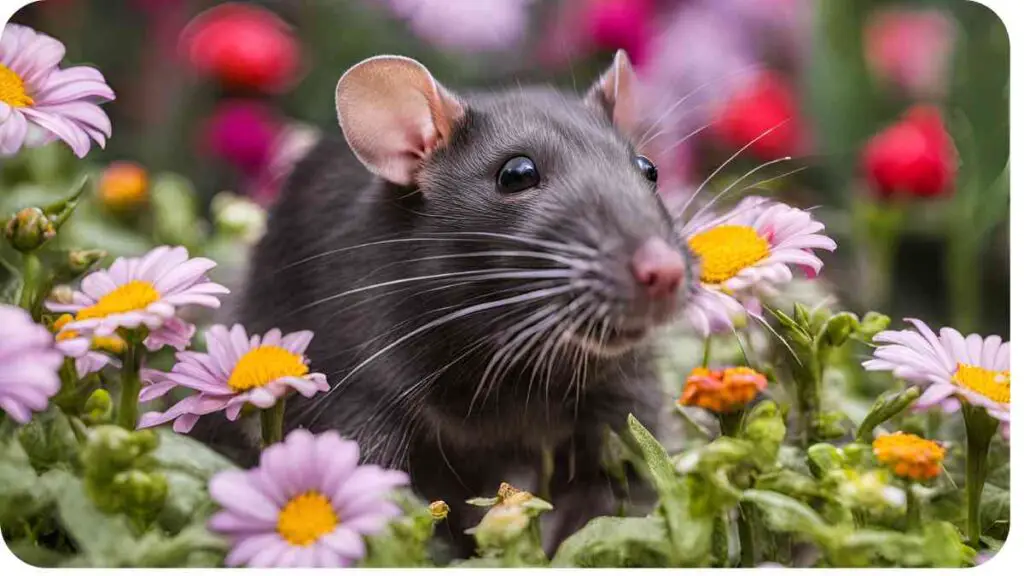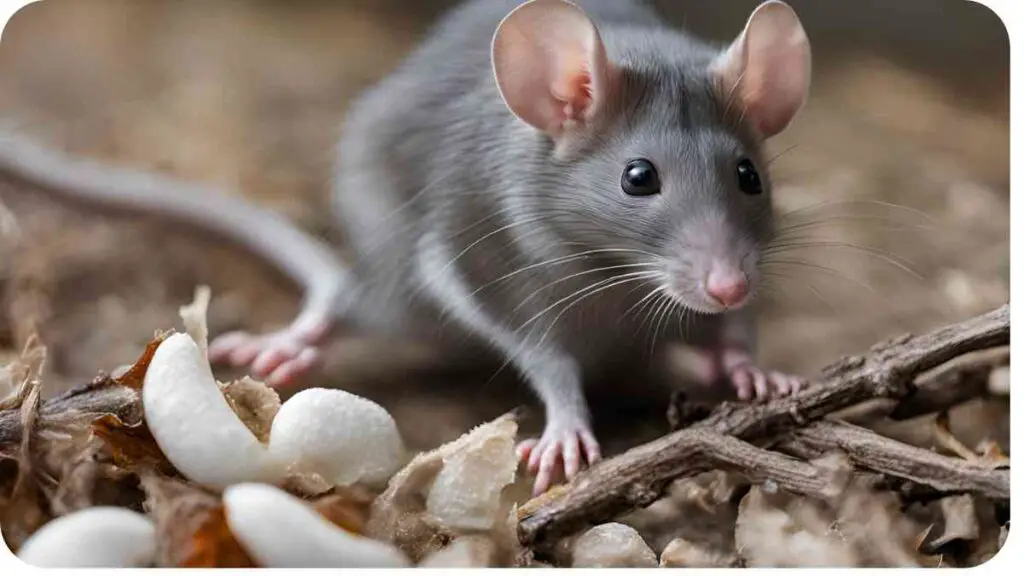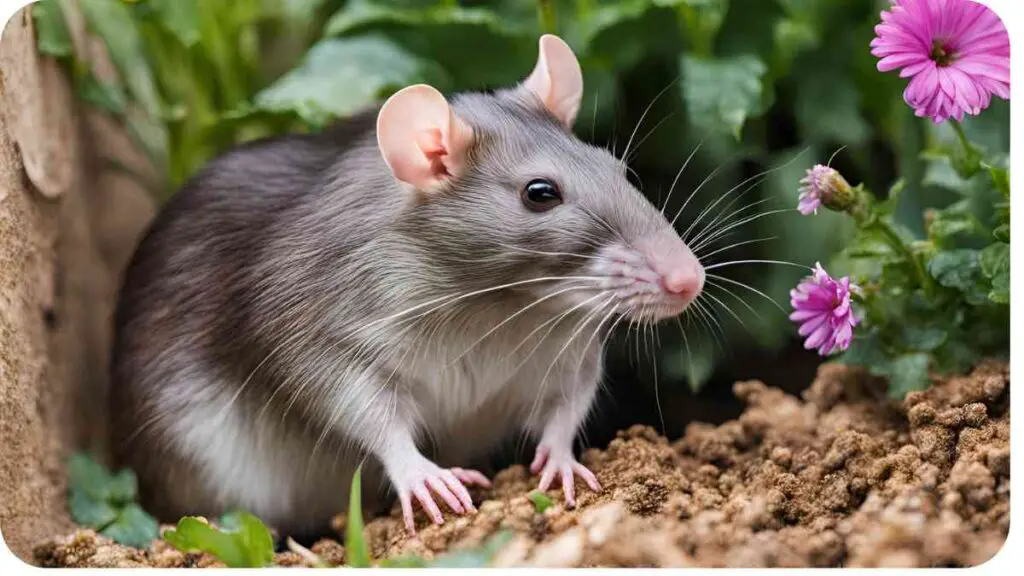Rats can quickly become a nuisance in your flower beds, wreaking havoc on your carefully tended plants and posing potential health risks. However, with the right approach, you can effectively get rid of these unwelcome pests and protect your garden oasis.
In this article, we’ll explore various methods for eliminating rats from your flower beds, from prevention strategies to trapping techniques and more.
| Key Takeaways |
|---|
| Understand rat behavior and signs of infestation. |
| Implement preventive measures to keep rats out. |
| Use humane trapping methods to capture rats effectively. |
| Properly dispose of rat carcasses to prevent odors. |
| Regularly maintain rat-free flower beds. |
2. Understanding Rat Behavior
Before diving into eradication methods, it’s crucial to understand the behavior of rats. Rats are highly adaptable creatures, seeking out food, water, and shelter in human environments. Flower beds provide an attractive habitat for rats due to the abundance of food sources like seeds, bulbs, and plant roots. Additionally, the shelter provided by dense vegetation makes flower beds an ideal nesting spot for rats.
To safeguard your blossoms, ensure flower beds are free from feline intrusion. Learn effective methods to deter cats and protect your garden sanctuary.
3. Signs of Rat Infestation in Flower Beds

Identifying the presence of rats in your flower beds early on is key to preventing further damage. Look out for telltale signs such as:
- Gnaw Marks: Rats have a tendency to gnaw on various objects, including plant stems, roots, and bulbs.
- Droppings: Rat droppings are typically dark, cylindrical, and around 1/2 to 3/4 inch in length.
- Burrows: Rats may create burrows or tunnels in the soil beneath your flower beds.
- Visible Rat Activity: Keep an eye out for rats scurrying around your garden, especially during dusk and dawn when they are most active.
| Signs of Rat Infestation |
|---|
| Gnaw Marks |
| Droppings |
| Burrows |
| Visible Rat Activity |
4. Health Risks Associated with Rat Infestation
Rat infestations pose serious health risks to humans and pets. Rats can transmit diseases through their urine, droppings, and saliva, including leptospirosis, hantavirus, and salmonellosis. Furthermore, their constant gnawing can damage electrical wiring, leading to fire hazards. Therefore, swift action is necessary to mitigate these health and safety concerns.
5. Prevention Methods
Preventing rats from entering your flower beds in the first place is the most effective strategy for rat control. Here are some preventive measures to consider:
Combat pesky squirrels invading your flower garden with strategic measures. Discover humane ways to discourage squirrel activity and preserve your floral haven.
Sealing Entry Points
Inspect your garden for any gaps or openings that rats could use to access your flower beds. Seal cracks in walls, fences, and sheds, and ensure that doors and windows are properly fitted.
| Sealing Entry Points |
|---|
| Inspect for Gaps |
| Seal Cracks |
| Secure Doors/Windows |
Proper Waste Management
Keep your garden clean and free of debris, as piles of organic matter can attract rats. Dispose of garden waste promptly and store compost bins in sealed containers to prevent access by rodents.
| Proper Waste Management |
|---|
| Dispose of Garden Waste |
| Store Compost Securely |
| Keep Garden Clean |
Use of Natural Repellents
Certain plants and substances act as natural repellents for rats. Consider planting mint, lavender, or marigolds around your flower beds, as rats are known to dislike their strong scents. You can also sprinkle cayenne pepper or peppermint oil in and around your flower beds as a deterrent.
| Natural Repellents |
|---|
| Mint |
| Lavender |
| Marigolds |
| Cayenne Pepper |
| Peppermint Oil |
By implementing these prevention methods, you can significantly reduce the likelihood of rat infestations in your flower beds. However, if rats have already taken up residence, it may be necessary to employ trapping methods to eradicate them effectively.
Selecting the right weed killer ensures a thriving flower bed. Explore suitable weed control options to maintain a healthy and vibrant garden landscape.
6. Trapping Methods
Traps are a humane and effective way to control rat populations in your flower beds. Here are some common trapping methods to consider:
Snap Traps
Snap traps are a traditional and cost-effective option for trapping rats. These devices consist of a spring-loaded mechanism that snaps shut when triggered by the rat’s movement.
| Snap Traps |
|---|
| Cost-Effective |
| Easy to Set Up |
| Quick Results |
Snap traps should be placed along rat runways or near feeding areas, baited with enticing food such as peanut butter or chocolate.
Glue Traps
Glue traps are another option for capturing rats. These traps feature a sticky adhesive surface that immobilizes rats upon contact.
| Glue Traps |
|---|
| Easy to Use |
| No Bait Required |
| Non-Toxic |
Glue traps should be positioned along walls or near rat activity areas, with care taken to prevent unintended capture of non-target species.
Live Traps
Live traps offer a humane alternative for capturing rats without harming them. These traps capture rats alive, allowing you to release them elsewhere.
| Live Traps |
|---|
| Humane Option |
| Reusable |
| Requires Relocation |
Live traps should be baited with enticing food and placed in areas frequented by rats. Once captured, rats should be released far away from your property to prevent their return.
7. Poisoning Rats: Pros and Cons

While poisoning rats may seem like a quick fix, it comes with several drawbacks. Poison baits pose risks to children, pets, and non-target wildlife if ingested accidentally. Additionally, poisoned rats may die in inaccessible areas, leading to foul odors and potential secondary poisoning of predators.
Revitalize your flower beds post-winter with comprehensive cleaning techniques. Ensure optimal conditions for spring growth by clearing debris and preparing the soil.
Pros:
- Can be effective at reducing rat populations quickly.
- Requires minimal effort to administer.
Cons:
- Poses risks to children and pets.
- May result in secondary poisoning of wildlife.
- Rats may die in inaccessible areas, leading to odors.
Given the potential risks and drawbacks, it’s advisable to explore alternative trapping methods before resorting to poison baits.
8. Proper Disposal of Rat Carcasses
Regardless of the trapping method used, it’s essential to dispose of rat carcasses properly to prevent contamination and odors. Wear gloves and use a sealed plastic bag to remove carcasses from traps, then dispose of them in an outdoor trash bin.
9. Maintaining Rat-Free Flower Beds

Once you’ve successfully eradicated rats from your flower beds, it’s important to maintain a rat-free environment. Regularly inspect your garden for signs of rat activity and promptly address any potential entry points or attractants.
10. Common Mistakes to Avoid
When dealing with rat infestations, avoid these common mistakes that can hinder your eradication efforts:
- Using ineffective trapping methods.
- Failing to address underlying attractants.
- Neglecting to seal entry points.
By learning from these common mistakes, you can increase the effectiveness of your rat control efforts and keep your flower beds free from unwanted pests.
Confront overgrown weeds in your flower beds with effective strategies. Learn step-by-step methods to reclaim your garden space and restore its beauty.
11. Professional Pest Control Services
If you’re struggling to manage a severe rat infestation, don’t hesitate to seek professional pest control services. Experienced pest control professionals can assess the extent of the infestation and implement targeted eradication strategies to restore the health and safety of your garden.
12. Conclusion
Getting rid of rats in your flower beds requires a multi-faceted approach that includes prevention, trapping, and proper disposal methods. By understanding rat behavior, implementing preventive measures, and using effective trapping techniques, you can reclaim your flower beds from these unwanted pests and enjoy a rat-free garden oasis.
Remember to prioritize safety and humane treatment throughout the eradication process, and don’t hesitate to seek professional assistance if needed. With persistence and determination, you can successfully eliminate rats from your flower beds and protect your plants and health.
Further Reading
- Gardeners World: Rats in the Garden
- Explore tips and advice on dealing with rats in your garden, from identifying signs of infestation to implementing effective control measures.
- House Beautiful: How to Get Rid of Rats in the Garden
- Discover practical strategies for eliminating rats from your garden space, including prevention methods and humane trapping techniques.
- Epic Gardening: How to Rat-Proof Your Garden
- Learn how to create a rat-proof garden environment, from securing compost bins to choosing rat-resistant plants.
FAQs
How do I know if I have rats in my flower beds?
Rats leave behind gnaw marks, droppings, burrows, and visible activity. Look out for these signs to identify rat infestations in your flower beds.
What are the health risks associated with rat infestations?
Rat infestations can transmit diseases such as leptospirosis, hantavirus, and salmonellosis through their urine, droppings, and saliva, posing risks to human and pet health.
What are some preventive measures to keep rats out of flower beds?
Seal entry points, practice proper waste management, and use natural repellents such as mint and lavender to deter rats from entering your flower beds.
What trapping methods can I use to capture rats in my flower beds?
Snap traps, glue traps, and live traps are common trapping methods used to capture rats in flower beds. Each method has its pros and cons, so choose the one that best suits your needs.
Is poisoning rats a recommended method for controlling rat populations in flower beds?
While poisoning rats may seem effective, it comes with risks to children, pets, and non-target wildlife. Explore alternative trapping methods before considering poison baits.

For 15 years, Hellen James has worked in the gardening industry as an expert and landscape designer. During her career, she has worked for a variety of businesses that specialize in landscaping and gardening from small firms to large corporations.

